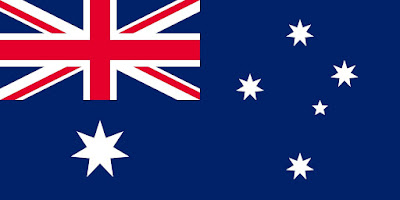Created: 17.04.2020
Australia Summary
Location: the continent of Australia
Capital city: Canberra
States: New South Wales, Queensland, South Australia, Tasmania, Victoria, Western Australia
Territories: Australian Capital Territory and the Northern Territory
Population: 25,7 million
Currency: Australian dollar AUD
Universities: Australian National University, the University of Sydney, University of Melbourne, the University of Sunshine Coast
State system: federal, parliamentary, constitutional monarchy
Head of state: officially the monarch
Power: executive - the Federal Executive Coucil with the Prime Minister and Governor-General, judicial - courts, legislative - the Parliament (the House of Representatives and the Senate)
Flag: based on the British maritime Blue Ensign with the Union Jack in the canton (upper hoist quarter), defaced with the Commonwealth Star and five stars of the Southern Cross constellation in the fly half
Anthem: Advance Australia Fair
Geography: Great Barrier Reef, Uluru (Ayers Rock), Lake Eyre, Great Victoria Desert, Great Dividing Range, Tasmania (island)
Climate: variable, steppe, temperate and tropical climate, with droughts and heat-related records
Highest mountain: Mount Kosciuszko 2228m
Rivers: Murray, Darling, Murrumbidgee, Lachlan
Sights: Sydney Opera House, Bondi Beach and Sydney Harbour Bridge in Sydney, Old Parliament House and Parliament House in Canberra, the Shrine of Remembrance and the Royal Exhibiton Building in Melbourne
Australia, officially the Commonwealth of Australia, is a sovereign country comprising the mainland of the Australian continent, the island of Tasmania and numerous other islands. It is the world's sixth-largest country by total area. The country is still officially a dominion of the British Empire, since 1901.
The head of the state is still officially the British monarch, Queen Elizabeth II. She is represented by the Governor-General. The head of the government is the Prime Minister. The Parliament consists of the Senate and the House of Representatives. The Chief Justice of Australia is the presiding justice of the High Court of Australia.
The population of 25,7 million is highly urbanised and heavily concentrated on the eastern seaboard. The population density is one of the lowest in the world. The capital city is Canberra with 427 thousand inhabitants. The largest city is Sydney with 5,3 million people. Other metropolitan areas include Melbourne, Brisbane, Perth and Adelaide. About 95% of the inhabitants are of British origin and about 2,8% are Indigenous Australians. The main language is Australian English, but other languages, including aboriginal, are spoken and many people are bilingual.
The Australian climate varies from warm to subtropical. The continent is in the southern hemisphere which means that it has summer in December, January and February. The tropical forests in the north and north-east are displaced by savanna and grassland. The south-east is covered with forests of eucalyptus and other evergreen trees. Deserts and the tropical northern part are practically uninhabited. Australia is the flattest and driest continent with the least fertile soils.
The continent has a very specific fauna and flora because it was isolated for a long time. The typical Australian animals include the kangaroo, koala bear, dingo, platypus, Tasmanian devil, and wombat. Many European animals were brought to the continent and now are a threat to the indigenous species.
Humans inhabited Australia at least 65 thousand years ago, by land bridges from Southeast Asia. The Indigenous peoples, Aboriginal Australians, have a very specific culture and history. The continent was discovered by the Dutch in 1606 and Spanish and English explorers visited the area for over a century. In 1770, James Cook claimed the land for Britain and they sent a fleet of ship to establish a new penal colony. Many of the Aboriginees dies due to infectious disease and conflicts with the settlers. A gold rush began in the 1850s and in 1901, federation of colonies was achieved as a dominion of the British Empire. The Statute of Westminster formally ended most of the constitutional links between Australia and the UK in 1931.
Australia is a wealthy country with a relatively low rate of poverty. It is a developed country with a large economy and rich natural resources. It is a major exporter of agrigultural products, especially wheat, wine and wool. The main industries are iron, steel, textiles, electrical equipment, chemicals, cars, aircrafts, ships and machinery. Australia mines coal, oil and gas, iron ore, gold and many other metals. ONly 9% of the land is arable.
Australia was influenced primarily by the Anglo-Celtic Western culture and its Indigenous people. Australian comedy has a strong tradition of self-mockery, perhals best represented by the Crocodile Dundee films. Vegemite, pavlova, lamingtons and meat pies are regarded as iconic Australian foods. The country is a powerhouse in water-based sports, such as swimming and surfing.
Some of the most famous Australians are Hugh Jackman, Nicole Kidman, Mel Gibson, Heath Ledger, Chris Hemsworth, Cate Blanchett, Kylie Minogue, Hugo Weaving and Margot Robbie. The legendary rock band AC/DC is from Australia. Howard Florey was an Australian pharmacologist and pathologist who shared the Nobel Prize with Alexander Fleming and Ernst Chain for the development of penicilin. Mark Oliphant was an Australian physicist who played an important role in the first experimental demonstration of nuclear fusion and in the development of nuclear weapons.



No comments:
Post a Comment